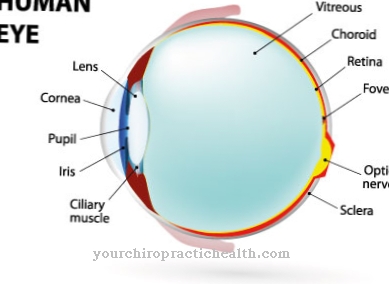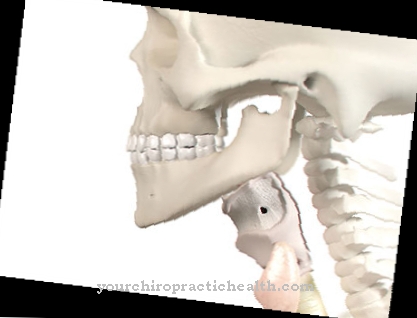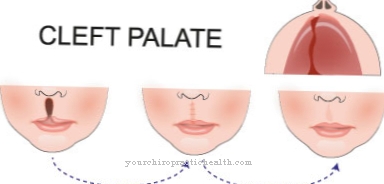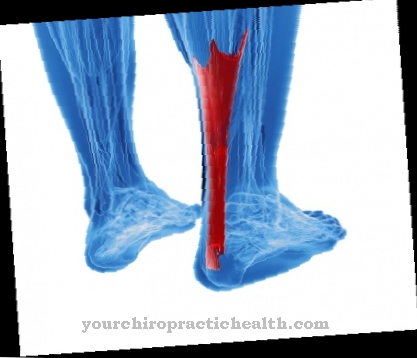Caput medusae describes the appearance of varicose veins on the abdomen, which can occur as a result of portal hypertension caused by severe liver diseases. The ailment is eliminated by treating the liver disease.
What is caput medusae?

© Alila Medical Media - stock.adobe.com
The term caput medusae is understood to mean the swelling and appearance of the veins in the navel area, which appear intertwined and protrude under the upper abdominal wall. These are visually reminiscent of the snakes on Medusa's head from Greek mythology.
Caput medusae is not an independent disease, but a consequence of high blood pressure in the portal vein (abdominal artery), caused by blood congestion. Portal hypertension is a symptom of severe liver disease and can lead to the development of other varicose veins, for example in the esophagus.
causes
The causes can be found in liver diseases, especially in cirrhosis of the liver, which is why this is emphasized here. The portal vein carries blood from the stomach, intestines, and spleen to the liver. The blood is enriched with nutrients and toxins through digestion. The toxins are filtered out in the liver.
If the blood flow is blocked by a blockage (tumor, converted connective tissue or parasites that enter the liver through food intake), blood congestion occurs. Narrowings in the abdominal artery can cause blood clots to form in the portal vein. Cirrhosis of the liver can be caused by heavy alcohol consumption, fatty liver disease or an infectious inflammation of the liver.
Long-term use of prescription and over-the-counter drugs (antibiotics, painkillers, psychotropic drugs) can also lead to liver diseases. Hereditary metabolic disorders can rarely cause liver disease.
You can find your medication here
➔ Medicines for jaundice and liver problemsSymptoms, ailments & signs
Specific symptoms are difficult to identify in the early stages of liver disease and are often played down. Fatigue, weakness, loss of appetite and reduced performance occur. Upper abdominal pain, gas and a feeling of fullness can be misinterpreted as symptoms of an infection or as menstrual cramps.
A whitish discoloration of the fingernails, spider web-shaped new blood vessels on the skin, reddening of the tongue (liver tongue), frequent itching and susceptibility to infections are also common. Jaundice can occur as a result of bile build-up. Hormonal disorders (menstrual disorders) are also possible.
Diagnosis & course
The upper abdomen is examined for liver problems. The diagnosis is made by a resident specialist or in a specialist clinic. Important causes of the high pressure (liver cirrhosis, tumor, ascites) are determined by imaging procedures such as ultrasound, computed tomography or magnetic resonance tomography.
The previous medical history is decisive: Did the person affected have liver problems as a child? Does the patient drink alcohol or take strong medication, if so, since when? Were the parents alcoholics? Are there any known severe liver diseases in the family? Are there any other metabolic disorders?
The increase in specific liver values (transaminases) can also provide an indication of impaired liver function. The course depends on the severity and cause of the underlying disease as well as on the cooperation of the patient. If the condition is not treated, brain function can be impaired.
Varicose veins in the esophagus may be present and are found by gastroscopy. These can cause the stool to turn black, inflammation of the stomach lining, and vomiting of blood. There is a risk of bleeding to death due to unnoticed bleeding in the esophagus.
Around one in five dies from it. If these varicose veins are treated successfully and the person concerned stops consuming alcohol, they can regress. Pathological emaciation due to disturbed digestion is also possible. Since the liver can no longer adequately detoxify the body, ammonia acids form in the brain.
This can lead to depression, personality changes, confusion and twilight states. In men, severe liver disease can lead to impotence and breast formation. In the worst case, the liver disease leads to fatal liver failure.
Complications
As a rule, severe discomfort and pain in the liver occurs with the head of the medusae. Therefore this is treated in the foreground in this disease. The symptoms, however, are not characteristic and are often similar to symptoms of common flu or gastrointestinal flu. Those affected suffer from severe abdominal pain and flatulence.
Not infrequently, there is also a strong feeling of fullness, even if the patient does not eat any food. There is also a loss of appetite, which can lead to underweight. Due to the undersupply, the patient often feels weak and listless and can no longer perform any physical work.
In addition, the skin can itch and the person affected is very susceptible to various infections. The quality of life is extremely reduced by the disease and the patient cannot live his everyday life normally. Symptoms often lead to depression and a general feeling of confusion.
The treatment is causal and is mainly carried out with the help of surgical interventions or beta blockers. There are no further complications. The affected person must also follow a strict diet. Serious cases require a liver transplant. In the case of diabetes, this must be treated.
When should you go to the doctor?
A doctor should be consulted if the veins in the area of the navel swell. Caput medusae indicates a serious underlying disease that needs to be diagnosed and treated. It is particularly important to inform a doctor if accompanying symptoms occur.
Varicose veins, which are associated with fatigue, weakness and loss of appetite, indicate liver disease. In the further course, symptoms of jaundice usually appear - at the latest then medical advice is required. People who already suffer from liver problems or metabolic disorders are particularly prone to caput medusae.
If you have visible varicose veins, it is best to talk to your family doctor if you have these risk factors. If depression, personality changes or confusion and twilight states set in, the disease may have already progressed further. In addition to the doctor, a therapist should also be consulted in this case. In the worst case - if the causative disease is not adequately treated - liver failure occurs. Then the rescue service has to be called in and first aid has to be given.
Doctors & therapists in your area
Treatment & Therapy
The high pressure is lowered by beta blockers or surgical procedures. The varicose veins are life-threatening and must be destroyed. In severe cases of congestion, a stent is placed in the liver. Alcohol consumption must be stopped so that pathologically altered liver tissue can regenerate itself.
If necessary, an addiction treatment is advisable. Instead of heavy medication, take natural remedies whenever possible. Losing excess weight and eating a balanced diet are important. No special diet is necessary. Dairy products promote liver function and are therefore recommended.
In severe cases of cirrhosis of the liver, a liver transplant becomes essential to save the patient's life. The liver values must be checked at regular intervals. The costs of treating the liver disease are covered by the statutory health insurance companies.
Heavy carrying is to be avoided, as a damaged liver can tear from the stress. Diabetes should be treated consistently. Dehydrators or a puncture can help with ascites. A sufficient intake of vitamin B is important. It is stored in the liver and protects against nerve damage.
There is currently no drug available to cure cirrhosis of the liver. In order to maintain brain performance, a low-protein diet to lower the level of ammonia in the blood is advisable. Lactulose can promote the excretion of ammonia through the intestines.
Outlook & forecast
The prognosis of the caput medusae depends on the underlying disease. In the most severe case, the patient dies prematurely or has an intermittent course.
If the patient suffers from a tumor, surgery and subsequent cancer therapy are necessary. There is a potential risk to life for the person concerned. Health development is particularly critical when cancer cells have already spread in the organism and metastases have developed.
Another unfavorable prognosis is present with liver cirrhosis. The tissue damage to the liver is irreparable. The lifespan is shortened and the risk of developing a tumor increases. Often the only salvation for the patient is an organ transplant. This is associated with numerous side effects and can lead to lifelong impairment.
Every fifth person affected dies of the caput medusae. The main reason for this is the usually severe underlying disease. There is a prospect of a cure as soon as the existing varicose veins have been successfully removed and the cause is permanently cured. In the case of alcohol addiction, abstaining from the consumption of alcohol is a prerequisite for healing.
Once an eating disorder is diagnosed, the patient must reach the recommended normal weight in order to experience recovery. In a large number of cases, a special diet is prescribed that minimizes the risk of the caput medusae recurring.
You can find your medication here
➔ Medicines for jaundice and liver problemsprevention
The best prevention against liver disease and thus against hypertension is to avoid excessive alcohol consumption. Painkillers should be taken as infrequently as possible. It is not advisable to travel to countries with a high risk of hepatitis or to vaccinate in good time.
Obesity should be avoided as fatty liver disease can turn into cirrhosis in the long term. Diabetes can be prevented with a healthy diet and sufficient exercise. Care should be taken to ensure sufficient exercise.
Aftercare
Follow-up care for caput medusae usually depends very much on the underlying disease, so that no general information can be given here.However, since the illness is associated with a stay in a hospital and surgical interventions, the person affected must recover from these and must not exert themselves physically after the intervention. Eating a healthy diet is also important so as not to strain the liver.
Alcohol should be avoided. Obesity should also be avoided in the case of caput medusae. If the patient is also suffering from diabetes, appropriate treatment for diabetes must be initiated. A direct cure of caput medusae cannot be achieved, although the disease can be limited by a low-protein diet.
In the case of a liver transplant, the usual measures should be taken during such an operation, with the wound and the function of the new liver constantly monitored. It cannot be universally predicted whether the patient's life expectancy will be reduced despite the healing of the caput medusae. If the head was caused by a tumor, the body must be checked for other tumors or metastases. Regular preventive examinations are also useful here.
You can do that yourself
"The head of Medusa" becomes visible when the veins in the brook protrude strongly due to permanent congestion in the portal vein circulation of the liver. The cause of this is almost always a severe liver disease. Those affected should therefore by no means downplay this symptom as a purely cosmetic problem, but rather consult a doctor promptly.
What the patient himself can contribute to the therapy depends on the cause of the underlying disease, which is almost always cirrhosis of the liver. Cirrhosis of the liver can be triggered by excessive alcohol consumption over a long period of time, fatty liver disease or an infectious liver inflammation. If continued alcohol abuse is responsible for the damage to the liver, the person concerned must immediately stop drinking or at least reduce it drastically.
This usually does not work without professional help, as those affected are almost always dependent on alcohol. These patients should start a withdrawal treatment with accompanying psychotherapy, as the therapy significantly reduces the risk of relapse into addiction. The same applies if the cirrhosis of the liver is not due to alcohol but to the abuse of drugs.
In the case of fatty liver, diet plays a decisive role. The right diet can cause the fatty liver to regress completely. In these cases, however, patients usually not only need medical help, but should also consult a competent ecotrophologist who will help them to permanently change their diet.



.jpg)








.jpg)



.jpg)










.jpg)
